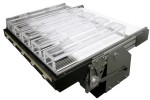Authors
Nees TA, Tappe-Theodor A, Sliwinski C, Motsch M, Rupp R, Kuner R, Weidner N, Blesch A.
Lab
Spinal Cord Injury Center, Heidelberg University Hospital, Heidelberg, Germany bPharmacology Institute, University of Heidelberg, Heidelberg, Germany
Journal
Pain.
Abstract
Below-level central neuropathic pain (CNP) affects a large proportion of spinal cord injured individuals. To better define the dynamic changes of the spinal cord neural network contributing to the development of CNP after spinal cord injury (SCI), we characterized the morphological and behavioral correlates of CNP in female C57BL/6 mice after a moderate T11 contusion SCI (50 kdyn) and the influence of moderate physical activity. Compared with sham-operated animals, injured mice developed mechanical allodynia 2 weeks post injury when tested with small-diameter von Frey hair filaments (0.16 g and 0.4 g filament), but presented hyporesponsiveness to noxious mechanical stimuli (1.4 g filament). The mechano-sensory alterations lasted up to 35 days post injury, the longest time point examined. The response latency to heat stimuli already decreased significantly 10 days post injury reaching a plateau 2 weeks later. In contrast, injured mice developed remarkable hyposensitivity to cold stimuli. Animals that underwent moderate treadmill training (2 × 15 minutes; 5 d/wk) showed a significant reduction in the response rate to light mechanical stimuli as early as 6 days after training. Calcitonin gene-related peptide (CGRP) labeling in lamina III-IV of the dorsal horn revealed significant increases in CGRP-labeling density in injured animals compared with sham control animals. Importantly, treadmill training reduced CGRP-labeling density by about 50% (P < 0.01), partially reducing the injury-induced increases. Analysis of IB4-labeled nonpeptidergic sensory fibers revealed no differences between experimental groups. Abnormalities in temperature sensation were not influenced by physical activity. Thus, treadmill training partially resolves signs of below-level CNP after SCI and modulates the density of CGRP-labeled fibers.
BIOSEB Instruments Used:
Treadmill (BX-TM),Passive avoidance (LE870)

 Douleur - Allodynie/Hyperalgésie Thermique
Douleur - Allodynie/Hyperalgésie Thermique Douleur - Spontanée - Déficit de Posture
Douleur - Spontanée - Déficit de Posture Douleur - Allodynie/Hyperalgésie Mécanique
Douleur - Allodynie/Hyperalgésie Mécanique Apprentissage/Mémoire - Attention - Addiction
Apprentissage/Mémoire - Attention - Addiction Physiologie & Recherche Respiratoire
Physiologie & Recherche Respiratoire
 Douleur
Douleur Système Nerveux Central (SNC)
Système Nerveux Central (SNC)  Neurodégénérescence
Neurodégénérescence Système sensoriel
Système sensoriel Système moteur
Système moteur Troubles de l'humeur
Troubles de l'humeur Autres pathologies
Autres pathologies Système musculaire
Système musculaire Articulations
Articulations Métabolisme
Métabolisme Thématiques transversales
Thématiques transversales Bonne année 2025
Bonne année 2025 
